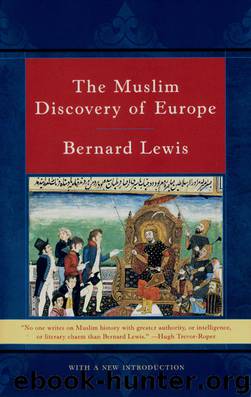The Muslim Discovery of Europe by Bernard Lewis

Author:Bernard Lewis [Lewis, Bernard]
Language: eng
Format: azw3, epub
ISBN: 9780393245578
Publisher: W. W. Norton & Company
Published: 2001-10-17T04:00:00+00:00
VI
Religion
For the Muslim, religion was the core of identity, of his own and therefore of other men’s. The civilized world consisted of the House of Islam, in which a Muslim government ruled, Mulim law prevailed, and non-Muslim communities might enjoy the tolerance of the Muslim state and community provided they accepted the conditions. The basic distinction between themselves and the outside world was the acceptance or rejection of the message of Islam. The conventional nomenclature of physical and even human geography was at best of secondary significance. Muslim writers, as we have seen, were aware of the fact that there were peoples beyond the northern border called Romans, Franks, Slavs, and other names, speaking a bewildering variety of languages. But this in itself was unremarkable. There were many races and nations within the Islamic oecumene and, although the Muslims had preferred to establish a very limited number of languages as the media of government, culture, and commerce, they too could parallel the profusion of local dialects and idioms characteristic of the European continent.
The real difference was religion. Those who professed Islam were called Muslims and were part of God’s community, no matter in which country or under what sovereign they lived. Those who rejected Islam were infidels. The Arabic word is kāfir, from a root meaning to disbelieve or deny, normally used only of those who disbelieve in the Islamic message and deny its truth.
Strictly speaking, the term kāfir applies to all non-Muslims. In Arabic, Persian, and Turkish usage, however, it came to be virtually synonymous with Christian. In the same way the House of War was seen more and more as consisting principally of the rival faith and polity which thought of itself first as Christendom and later as Europe. Muslims were of course aware of other infidels besides the Christians. Some, like the Hindus and Buddhists of Asia, were too remote to have much impact on the perceptions and usage of Middle Eastern and Mediterranean Islamic communities. Others, like the non-Muslim inhabitants of black Africa, had much closer relations with them but were seen primarily as polytheists and idolaters, and are commonly so designated. Only two other religions were known in the Middle East, Zoroastrianism and Judaism, and both were too small to be of much significance. Both had lost their political power and were no longer considered to be in a state of war with Islam. Jews were seen only as dhimms, and the dwindling remnant of the Zoroastrians were more or less admitted to the same status. By Ottoman times the term kāfir, even in official usage, does not include Jews. In innumerable fiscal and other documents dealing with the affairs of the non-Muslim communities, the customary Ottoman formula is “kāfirs and Jews”, with the obvious implication that the first term does not include the second. This is in part a testimony to the preeminence of the Christians, in part a recognition of the unflawed monotheism of the Jews. In Ottoman (and modern) Turkish usage the term kāfir is often replaced by gavur, applied to infidels in general and Christians in particular.
Download
The Muslim Discovery of Europe by Bernard Lewis.epub
This site does not store any files on its server. We only index and link to content provided by other sites. Please contact the content providers to delete copyright contents if any and email us, we'll remove relevant links or contents immediately.
| Africa | Americas |
| Arctic & Antarctica | Asia |
| Australia & Oceania | Europe |
| Middle East | Russia |
| United States | World |
| Ancient Civilizations | Military |
| Historical Study & Educational Resources |
Empire of the Sikhs by Patwant Singh(22767)
The Wind in My Hair by Masih Alinejad(4843)
The Templars by Dan Jones(4558)
Rise and Kill First by Ronen Bergman(4545)
The Rape of Nanking by Iris Chang(4023)
12 Strong by Doug Stanton(3419)
Blood and Sand by Alex Von Tunzelmann(3055)
The History of Jihad: From Muhammad to ISIS by Spencer Robert(2505)
Babylon's Ark by Lawrence Anthony(2431)
The Turkish Psychedelic Explosion by Daniel Spicer(2245)
Gideon's Spies: The Secret History of the Mossad by Gordon Thomas(2235)
No Room for Small Dreams by Shimon Peres(2235)
Inside the Middle East by Avi Melamed(2230)
Arabs by Eugene Rogan(2193)
The First Muslim The Story of Muhammad by Lesley Hazleton(2154)
Bus on Jaffa Road by Mike Kelly(2035)
Come, Tell Me How You Live by Mallowan Agatha Christie(2026)
Kabul 1841-42: Battle Story by Edmund Yorke(1921)
1453 by Roger Crowley(1880)
